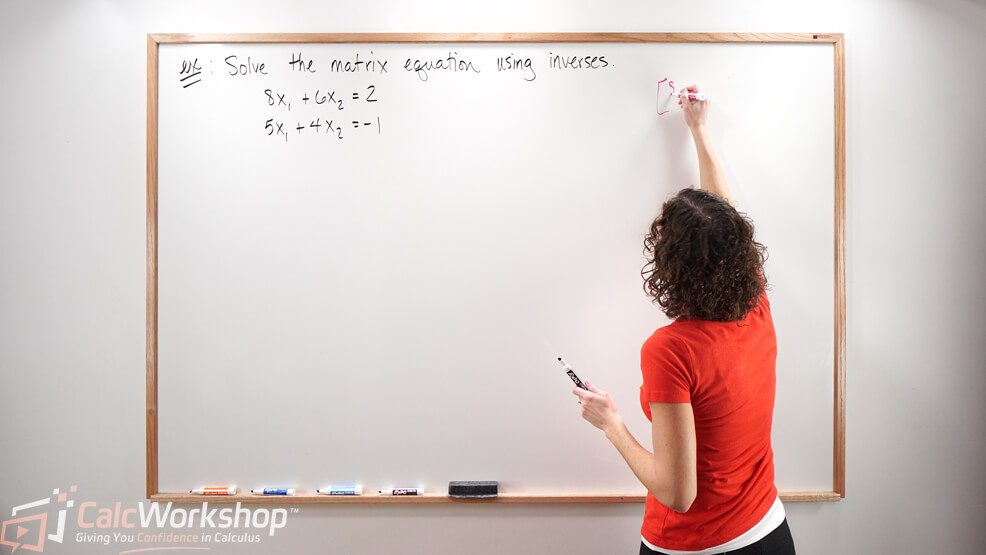Have you ever made a mistake, missed your turn, or gone too far? Sometimes in life, we need a redo, a U-turn, or a chance to undo something.

Jenn, Founder Calcworkshop®, 15+ Years Experience (Licensed & Certified Teacher)
Well, in mathematics, this is called the inverse. Addition undoes subtraction, multiplication undoes division, square root undoes a square, etc. And an inverse matrix undoes a matrix!
The Inverse Matrix, denoted
Why We Need Inverse Matrices
But why do we care? What’s the point?
Because we cannot divide by a matrix! Yes, you read that correctly. There is no division of matrices!
Therefore, to manipulate a matrix equation where division is not allowed, the only tool we can use is the inverse.
For example,
Therefore, we can use this property to our advantage when solving matrix equations because if A is a square
But before we solve matrix equations using inverses, let’s find out how to find an inverse of a matrix.
Finding the Inverse of a 2×2 Matrix
If
Notice that we are dividing by the determinant of
Invertible and Singular Matrices
Alright, so A is an invertible matrix if it has an inverse and is sometimes called nonsingular. This means that
However, not all matrices have inverses. Any matrix that is not invertible is called a singular matrix.
Why do we call a matrix that doesn’t have an inverse singular? As a mathematician, I have to say that it is because the determinant of the matrix is zero. But the “eccentric” side of me wants to believe it’s because the word “singular” means exceptional, rare, or even a bit odd. Therefore, if a matrix doesn’t have an inverse, it stands alone as being “unique,” as it doesn’t have a buddy to undo any mistakes – it stands alone.
Example: Identifying a Singular Matrix
Okay, so let’s practice.
Find the inverse of
First, we must calculate the determinant to tell us if the matrix is invertible.
Because our determinant is a number other than zero, we know that matrix
Easy, right?
Example
Let’s look at another problem.
Find the inverse of
First, we must calculate the determinant to tell us if the matrix is invertible.
Uh, oh! Well, because the determine is zero, matrix
Okay, so now it’s time to look at how we can use the Inverse of a Matrix to solve a system of linear equations, as
Solving Linear Equations with Inverse Matrices
So, all we have to do is find the inverse of
Example: Using Inverse Matrices to Solve a System of Linear Equations
For instance, let’s use the inverse to solve the following system.
First, let’s write the system of linear equations as a matrix equation
Next, we will find the determinant of matrix
Now we will apply our inverse formula for a
Finally, we will find the product of
So, this means that
Great!
Important Warnings: Invertibility and Order
Yet, there are two critical warnings that you must keep in mind: not every matrix is invertible, and order matters!
We’ve already talked about nonsingular (invertible) and singular (not invertible), but what’s so crucial about order?
As we learned about multiplying matrices in our previous lesson dealing with Matrix Operations, the product of two matrices AB doesn’t always equal BA.
Therefore, we must pay close attention to the fact that when solving matrix equations, the inverse of A must come before our
In our video lesson, we will work through several examples of how to move matrices from one side to the other, where we will pay close attention to order and placement.
As you can see, using inverses to solve matrices is pretty straightforward, but what do we do when the matrix is not
Algorithm for Finding Inverses of Larger Matrices
Well, we will have to use the inverse algorithm.
The inverse algorithm states that a square
In other words, we will augment matrix A with the Identity matrix of the same size.
Then we will use our row echelon techniques to transform the matrix so that:
Example: Applying the Inverse Algorithm to a 3×3 Matrix
For instance, let’s use the algorithm to find
First, we augment A with the Identity matrix of the same size.
Now, we use Gauss-Jordan Elimination
Notice that the Identity matrix moved from back to front!
This means:
Next Steps
In this video, you will:
- Work through the process together
- Examine the definition of Elementary Matrices and how they differ from the Identity matrix by one single elementary row operation
- Understand the importance of Elementary Matrices for future lessons on the invertible matrix theorem and properties of determinants
- Appreciate the significance of inverses for the journey ahead
Get ready to jump right in and explore!
Video Tutorial w/ Full Lesson & Detailed Examples

Get access to all the courses and over 450 HD videos with your subscription
Monthly and Yearly Plans Available
Still wondering if CalcWorkshop is right for you?
Take a Tour and find out how a membership can take the struggle out of learning math.